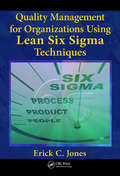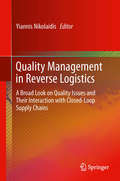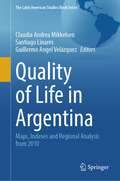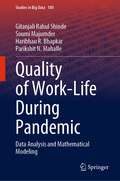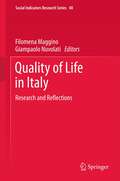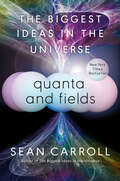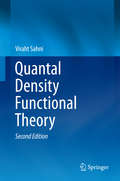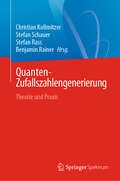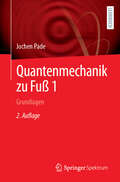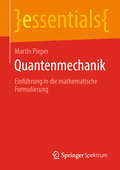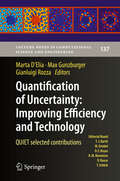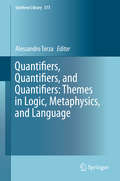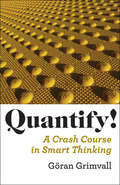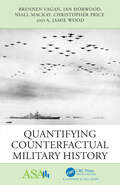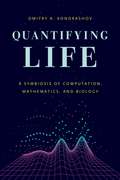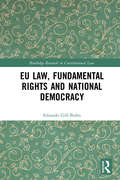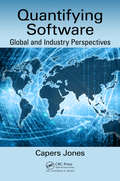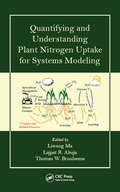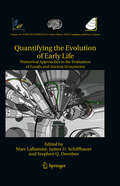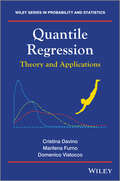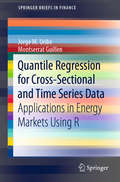- Table View
- List View
Quality Management for Organizations Using Lean Six Sigma Techniques
by Erick JonesThe next step in the evolution of the organizational quality field, Lean Six Sigma (LSS) has come of age. However, many challenges to using LSS in lieu of, in conjunction with, or integrated with other quality initiatives remain. An update on the current focus of quality management, Quality Management for Organizations Using Lean Six Sigma Techniqu
Quality Management in Reverse Logistics
by Yiannis NikolaidisQuality Management in Reverse Logistics intends to develop, collect, examine and evaluate a number of quality management (QM) tools and techniques, which can be applied in practice in order to understand, review and improve any closed-loop supply chain process. In other words, the book aims to examine the existing relationship between various well-developed and thoroughly studied quality issues, such as QM, quality assurance, standardization of processes and statistical quality control and the emerging research area of reverse logistics. Quality Management in Reverse Logistics contains modeling and quantitative methods that could be used by practitioners and academics in the reverse logistics industry, as well as a thorough description of QM tools and techniques. The book leads the potential reader to broaden their scope of thinking and acting in the new, promising area of reverse logistics, where QM can be applied.
Quality of Life in Argentina: Maps, Indexes and Regional Analysis from 2010 (The Latin American Studies Book Series)
by Claudia Andrea Mikkelsen Guillermo Angel Velázquez Santiago LinaresThis book studies inequalities in the quality of life of the Argentine population at the regional level. It considers the six regions of the National Statistical System: Northwest, Northeast, Cuyo, Pampa, Metropolitan, and Patagonia. A series of thematic maps is provided and interpreted, which are related to: a. socioeconomic issues (education, health, housing) and b. environmental aspects (environmental problems and recreational resources). These dimensions (socioeconomic and environmental) are integrated into quality of life indexes that allow the comparison of the situation of the population residing in any region of the national territory.
Quality of Life in Urban Landscapes: In Search of a Decision Support System (The Urban Book Series)
by Roberta Cocci Grifoni Rosalba D'Onofrio Massimo SargoliniThis volume introduces an innovative tool for the development of sustainable cities and the promotion of the quality of life of city inhabitants. It presents a decision-support system to orient public administrations in identifying development scenarios for sustainable urban and territorial transformations. The authors have split the volume into five parts, which respectively describe the theoretical basis of the book, the policies in question and indicators that influence them, the decision-support system that connects indicators to policies, the case study of Ancona, Italy, and potential future directions for this work. This volume is based on transdisciplinary research completed in May 2016 that involved about 40 researchers at The University of Camerino, Italy and other European universities. With purchase of this book, readers will also have access to Electronic Supplementary Material that contains a database with groups of indicators of assessment of urban quality of life and a toolkit containing the data processing system and management information system used in the book’s case study.
Quality of Work-Life During Pandemic: Data Analysis and Mathematical Modeling (Studies in Big Data #100)
by Parikshit N. Mahalle Gitanjali Rahul Shinde Soumi Majumder Haribhau R. BhapkarThis book is focused on the impact of the COVID-19 pandemic on different sectors, i.e., education, real estate, health, and agriculture. The lockdown has been announced to control the spread of COVID-19 infections, however people/industries/organizations were not ready for lockdown and it has greatly affected their growth. The front workers in the healthcare sector suffered a lot as major responsibilities they needed to carry on. The education sector is also hampered due to the pandemic as schools, colleges were closed and teaching, examinations were carried out on online platforms. These platforms were new to teachers as well as students. The real estate sector faced tremendous loss in this pandemic as people were scared and no one ready to invest their money in such an uncertain time. The agriculture filed is also suffered as raw materials required for agriculture were not available readily due to pandemic. This book presents a survey that is conducted to understand the impact of COVID-19 on the quality of work-life in various sectors. The survey is focused majorly on four sectors, i.e. education, healthcare, real estate and agriculture. Data analysis is done based on responses of survey and mathematical modeling is provided for each case study.
Quality of life in Italy
by Filomena Maggino Giampaolo NuvolatiThe outcome of the first Italian National Conference on Quality of Life, this volume is full of cogent analysis of topics and issues related to well being and quality of life, including focused papers on specific population groupings and discrete themes. Held in Florence in September 2010, the conference saw the creation of the Italian Association of Quality of Life Studies, devised as a forum for this varied field of research with a rapidly expanding profile in the context of the continuing financial crisis. The papers address a number of recognized quality-of-life concerns, including public health, wealth distribution, employment, political participation and the perception of crime. Contributors deploy innovative methods of analyzing official statistics that result in more complex and multidimensional indicators. Some papers provide data on other European nations that allow for comparative assessment, while others set out fresh approaches to evaluating quality of life itself. Highly relevant not just to academics, but to policy makers and practitioners in a range of sectors, this publication explores important aspects of a crucial contemporary subject.
Quanta and Fields: The Biggest Ideas in the Universe
by Sean CarrollThe instant New York Times bestsellerQuanta and Fields, the second book of Sean Carroll&’s already internationally acclaimed series The Biggest Ideas in the Universe, is an adventure into the bare stuff of reality. Sean Carroll is creating a profoundly new approach to sharing physics with a broad audience, one that goes beyond analogies to show how physicists really think. He cuts to the bare mathematical essence of our most profound theories, explaining every step in a uniquely accessible way. Quantum field theory is how modern physics describes nature at its most profound level. Starting with the basics of quantum mechanics itself, Sean Carroll explains measurement and entanglement before explaining how the world is really made of fields. You will finally understand why matter is solid, why there is antimatter, where the sizes of atoms come from, and why the predictions of quantum field theory are so spectacularly successful. Fundamental ideas like spin, symmetry, Feynman diagrams, and the Higgs mechanism are explained for real, not just through amusing stories. Beyond Newton, beyond Einstein, and all the intuitive notions that have guided homo sapiens for millennia, this book is a journey to a once unimaginable truth about what our universe is.
Quantal Density Functional Theory
by Viraht SahniThis book deals with quantal density functional theory (QDFT) which is a time-dependent local effective potential theory of the electronic structure of matter. The treated time-independent QDFT constitutes a special case. In the 2nd edition, the theory is extended to include the presence of external magnetostatic fields. The theory is a description of matter based on the 'quantal Newtonian' first and second laws which is in terms of "classical" fields that pervade all space, and their quantal sources. The fields, which are explicitly defined, are separately representative of electron correlations due to the Pauli exclusion principle, Coulomb repulsion, correlation-kinetic, correlation-current-density, and correlation-magnetic effects. The book further describes Schrödinger theory from the new physical perspective of fields and quantal sources. It also describes traditional Hohenberg-Kohn-Sham DFT, and explains via QDFT the physics underlying the various energy functionals and functional derivatives of the traditional approach to electronic structure.
Quanten-Zufallszahlengenerierung: Theorie und Praxis
by Stefan Rass Stefan Schauer Christian Kollmitzer Benjamin RainerDieses Buch bietet einen Überblick über die neuesten Implementierungen von Quanten-Zufallszahlengeneratoren (QRNGs) und untersucht insbesondere deren Beziehung zu klassischen statistischen Zufallsmodellen und numerischen Techniken zur Berechnung von Zufallszahlen. Der Leser - der idealerweise einen Hintergrund in klassischer Statistik, Informatik oder Kryptographie hat - wird Schritt für Schritt in die Welt der Quantenbits eingeführt, und es werden explizite Beziehungen zwischen QRNGs und ihren klassischen Gegenstücken aufgezeigt. Die Erzeugung von Zufallszahlen ist eine wichtige Säule der Kryptographie. Die Nutzung des Zufalls, der Quantenphänomenen innewohnt, ist ein sich rasch entwickelnder Zweig der Quantenkryptografie mit unzähligen Anwendungen für die Zukunft. Der Wert der Quantenzufälligkeit für kryptografische Zwecke wird empirisch durch statistische Auswertungen der Leistung von QRNGs im Vergleich zu klassischen Techniken zur Erzeugung echter und pseudozufälliger Zahlen nachgewiesen. Das Buch bietet dann einen Überblick über die technischen Implementierungen von QRNGs, bevor eine abschließende Diskussion über die wichtigsten Errungenschaften und verbleibenden Hindernisse auf diesem Gebiet die Berichterstattung abrundet und gleichzeitig die Tür für zukünftige Forschungsrichtungen öffnet.
Quantenmechanik zu Fuß 1: Grundlagen
by Jochen PadeDie beiden Bände von Quantenmechanik zu Fuß führen Schritt für Schritt in die Grundlagen der nichtrelativistischen Quantenmechanik ein.Dieser erste Band konzentriert sich hauptsächlich auf die wesentlichen Prinzipien, während Anwendungen und Erweiterungen des Formalismus in Band 2 zu finden sind.Um die Grundideen der Quantenmechanik und ihre mathematische Formulierung schnell und anschaulich darzustellen, wird in den ersten Kapiteln systematisch zwischen analytischer und algebraischer Darstellung gewechselt. Auf diese Weise können neben dem traditionellen Lehrstoff frühzeitig auch aktuelle Themen detailliert besprochen werden, wie z.B. Neutrino-Oszillationen und Quantenkryptographie. Ausgearbeitete Beispiele erleichtern den Zugang. Die erforderlichen mathematischen Werkzeuge werden dabei nach Bedarf eingeführt. Ein weiterer Schwerpunkt ist die Darstellung und Diskussion des Messproblems und anderer grundlegender konzeptueller Fragen. Ein Kapitel über die Postulate der Quantenmechanik schließt diesen ersten Band ab.Im Anhang findet sich eine kompakte Zusammenfassung der wichtigsten mathematischen Hilfsmittel, sodass auf ergänzende Literatur verzichten werden kann. Außerdem werden dort weiterführende Themen wie der Quanten-Zeno-Effekt und Time-delay-Experimente behandelt. Über 250 Übungsaufgaben mit ausführlichen Lösungen helfen dabei, das Verständnis für die behandelten Themen zu vertiefen.Die vorliegende überarbeitete und aktualisierte zweite Auflage ist um eine Einführung in einige Ideen und Probleme der relativistischen Quantenmechanik erweitert. In diesem ersten Band werden die Klein-Gordon- und die Dirac-Gleichung behandelt. Für die Relativistik benötigte Grundlagen anderer Gebiete werden in kompakter Form bereit gestellt (spezielle Relativitätstheorie, klassische Feldtheorie und Elektrodynamik).Quantenmechanik zu Fuß richtet sich an alle Studierenden der Physik und andere, die eine angemessen einfache, frische und moderne Einführung in die Quantenmechanik suchen. Das Buch eignet sich auch sehr gut zum Selbststudium.
Quantenmechanik zu Fuß 2: Anwendungen und Erweiterungen
by Jochen PadeDie beiden Bände von Quantenmechanik zu Fuß führen Schritt für Schritt in die Grundlagen der nichtrelativistischen Quantenmechanik ein.Während sich der erste Band mit den wesentlichen Prinzipien befasst, werden in diesem zweiten Band Anwendungen und Erweiterungen auf komplexere Probleme erörtert.Neben Gebieten, die zum traditionellen Stoff der Quantenmechanik gehören wie z.B. Symmetrien, Streutheorie oder Vielteilchenprobleme, werden auch aktuelle Themen ausführlich behandelt, etwa Verschränkung, Bellsche Ungleichung, Dekohärenz, Quantencomputer und andere Aspekte der Quanteninformation. Ausgearbeitete Beispiele erleichtern den Zugang. Die Realismusdebatte und andere konzeptuelle Fragen der Quantenmechanik werden ausführlich besprochen. Ein Kapitel über die Interpretationen der Quantenmechanik schließt diesen zweiten Band ab.Im Anhang wird das erforderliche mathematische Handwerkszeug kompakt zusammengestellt. Außerdem werden dort weiterführendeThemen wie der Lenz-Vektor, das Hardy-Experiment und der Shor-Algorithmus detailliert dargestellt. Über 150 Übungsaufgaben mit ausführlichen Lösungen helfen dabei, das Verständnis für die behandelten Themen zu vertiefen. Die vorliegende überarbeitete und aktualisierte zweite Auflage ist um eine Einführung in einige Ideen und Probleme der relativistischen Quantenmechanik erweitert. In diesem zweiten Band wird ein Überblick über die Quantenfeldtheorie gegeben und grundlegende Konzepte der Quantenelektrodynamik eingehend behandelt.Quantenmechanik zu Fuß richtet sich an alle Studierenden der Physik und andere, die eine angemessen einfache, frische und moderne Einführung in die Quantenmechanik suchen. Das Buch eignet sich auch sehr gut zum Selbststudium.
Quantenmechanik: Einführung in die mathematische Formulierung (essentials)
by Martin PieperWer schon immer die Hieroglyphen auf Sheldons Tafel in der Fernsehserie The Big Bang Theory verstehen oder ganz genau wissen wollte, was es mit dem Schicksal von Schrödingers Katze auf sich hat, findet in diesem essential eine kurze, anschauliche Einführung in die Welt der Quantenmechanik. Speziell fokussiert sich der Text auf die mathematische Beschreibung im Hilbertraum. Hierbei geht der Inhalt über populärwissenschaftliche Darstellungen hinaus, ist allerdings trotzdem durch die anschaulichen Beispiele für Lesende ohne spezielle Vorkenntnisse geeignet. Der Autor:Prof. Dr. Martin Pieper ist seit 2011 Professor für Mathematik und Simulation an der FH Aachen. Vor seinem Ruf an die FH Aachen war er wissenschaftlicher Mitarbeiter in der Abteilung Optimierung des Fraunhofer-Instituts für Techno- und Wirtschaftsmathematik.
Quantification of Uncertainty: QUIET selected contributions (Lecture Notes in Computational Science and Engineering #137)
by Gianluigi Rozza Marta D’Elia Max GunzburgerThis book explores four guiding themes – reduced order modelling, high dimensional problems, efficient algorithms, and applications – by reviewing recent algorithmic and mathematical advances and the development of new research directions for uncertainty quantification in the context of partial differential equations with random inputs. Highlighting the most promising approaches for (near-) future improvements in the way uncertainty quantification problems in the partial differential equation setting are solved, and gathering contributions by leading international experts, the book’s content will impact the scientific, engineering, financial, economic, environmental, social, and commercial sectors.
Quantifiers, Quantifiers, and Quantifiers: Themes in Logic, Metaphysics, and Language
by Alessandro TorzaThis volume covers a wide range of topics that fall under the 'philosophy of quantifiers', a philosophy that spans across multiple areas such as logic, metaphysics, epistemology and even the history of philosophy. It discusses the import of quantifier variance in the model theory of mathematics. It advances an argument for the uniqueness of quantifier meaning in terms of Evert Beth's notion of implicit definition and clarifies the oldest explicit formulation of quantifier variance: the one proposed by Rudolf Carnap. The volume further examines what it means that a quantifier can have multiple meanings and addresses how existential vagueness can induce vagueness in our modal notions. Finally, the book explores the role played by quantifiers with respect to various kinds of semantic paradoxes, the logicality issue, ontological commitment, and the behavior of quantifiers in intensional contexts.
Quantify!: A Crash Course in Smart Thinking
by Göran GrimvallGöran Grimvall is determined to help mere mortals understand how scientists get to the kernel of perplexing problems. Entertaining and enlightening, his latest book uses examples from sports, literature, and nature—as well as from the varied worlds of science—to illustrate how scientists make sense of and explain the world around us. Grimvall's fun-to-read essays and easy-to-follow examples detail how order-of-magnitude estimation, extreme cases, dimensional analysis, and other modeling methods work. They also reveal how nonscientists absorb these concepts and use them at home, school, and work. Grimvall's simple, elegant explanations will help you tap into your inner scientist. Read this book and enjoy your own "Aha!" moment.
Quantify!: A Crash Course in Smart Thinking
by Göran GrimvallEssays and examples that reveal how scientists figure things out: “An excellent piece of work with lots of fascinating information.” —Brian Clegg, Popular ScienceGöran Grimvall is determined to help mere mortals understand how scientists get to the kernel of perplexing problems. Entertaining and enlightening, his latest book uses examples from sports, literature, and nature—as well as from the varied worlds of science—to illustrate how scientists make sense of and explain the world around us.Grimvall’s fun-to-read essays and easy-to-follow examples detail how order-of-magnitude estimation, extreme cases, dimensional analysis, and other modeling methods work. They also reveal how nonscientists absorb these concepts and use them at home, school, and work.These simple, elegant explanations will help you tap into your inner scientist. Read this book and enjoy your own “Aha!” moment.“A wonderful read for everyone, emphasizing how scientists and engineers tend to think about examples from daily life that are expressed by numbers . . . Highly recommended.” —Choice
Quantifying Counterfactual Military History (ASA-CRC Series on Statistical Reasoning in Science and Society)
by Christopher Price Brennen Fagan Ian Horwood Niall MacKay A. Jamie WoodForces shaping human history are complex, but the course of history is undeniably changed on many occasions by conscious acts. These may be premeditated or responsive, calmly calculated or performed under great pressure. They may also be successful or catastrophic, but how are historians to make such judgements and appeal to evidence in support of their conclusions? Further, and crucially, how exactly are we to distinguish probable unrealized alternatives from improbable ones? This book describes some of the modern statistical techniques that can begin to answer this question, as well as some of the difficulties in doing so. Using simple, wellquantified cases drawn from military history, we claim that statistics can now help us to navigate the near-truths, the envelope around the events with which any meaningful historical analysis must deal, and to quantify the basis of such analysis. Quantifying Counterfactual Military History is intended for a general audience who are interested in learning more about statistical methods both in military history and for wider applications. Key Features: This book demonstrates how modern statistical techniques can measure the impact of counterfactual decisions. It examines the importance of counterfactual reasoning for both modern scholars and historical actors. It combines historical narrative, mathematical precision and data to create a straightforward presentation of both factual and counterfactual military history. It provides an original contribution to the debate over the validity and rigour of works of counterfactual history. It is written in a manner accessible to readers who have no formal training in History or Statistics.
Quantifying Life: A Symbiosis of Computation, Mathematics, and Biology
by Dmitry A. KondrashovSince the time of Isaac Newton, physicists have used mathematics to describe the behavior of matter of all sizes, from subatomic particles to galaxies. In the past three decades, as advances in molecular biology have produced an avalanche of data, computational and mathematical techniques have also become necessary tools in the arsenal of biologists. But while quantitative approaches are now providing fundamental insights into biological systems, the college curriculum for biologists has not caught up, and most biology majors are never exposed to the computational and probabilistic mathematical approaches that dominate in biological research. With Quantifying Life, Dmitry A. Kondrashov offers an accessible introduction to the breadth of mathematical modeling used in biology today. Assuming only a foundation in high school mathematics, Quantifying Life takes an innovative computational approach to developing mathematical skills and intuition. Through lessons illustrated with copious examples, mathematical and programming exercises, literature discussion questions, and computational projects of various degrees of difficulty, students build and analyze models based on current research papers and learn to implement them in the R programming language. This interplay of mathematical ideas, systematically developed programming skills, and a broad selection of biological research topics makes Quantifying Life an invaluable guide for seasoned life scientists and the next generation of biologists alike.
Quantifying Software: Global and Industry Perspectives (Routledge Research In Constitutional Law Ser.)
by Capers JonesSoftware is one of the most important products in human history and is widely used by all industries and all countries. It is also one of the most expensive and labor-intensive products in human history. Software also has very poor quality that has caused many major disasters and wasted many millions of dollars. Software is also the target of frequent and increasingly serious cyber-attacks. <P><P>Among the reasons for these software problems is a chronic lack of reliable quantified data. This reference provides quantified data from many countries and many industries based on about 26,000 projects developed using a variety of methodologies and team experience levels. The data has been gathered between 1970 and 2017, so interesting historical trends are available. <P><P>Since current average software productivity and quality results are suboptimal, this book focuses on "best in class" results and shows not only quantified quality and productivity data from best-in-class organizations, but also the technology stacks used to achieve best-in-class results. The overall goal of this book is to encourage the adoption of best-in-class software metrics and best-in-class technology stacks. It does so by providing current data on average software schedules, effort, costs, and quality for several industries and countries. <P><P>Because productivity and quality vary by technology and size, the book presents quantitative results for applications between 100 function points and 100,000 function points. It shows quality results using defect potential and DRE metrics because the number one cost driver for software is finding and fixing bugs. The book presents data on cost of quality for software projects and discusses technical debt, but that metric is not standardized. Finally, the book includes some data on three years of software maintenance and enhancements as well as some data on total cost of ownership.
Quantifying Software: Global and Industry Perspectives (Routledge Research In Constitutional Law Ser.)
by Capers JonesSoftware is one of the most important products in human history and is widely used by all industries and all countries. It is also one of the most expensive and labor-intensive products in human history. Software also has very poor quality that has caused many major disasters and wasted many millions of dollars. Software is also the target of frequent and increasingly serious cyber-attacks. Among the reasons for these software problems is a chronic lack of reliable quantified data. This reference provides quantified data from many countries and many industries based on about 26,000 projects developed using a variety of methodologies and team experience levels. The data has been gathered between 1970 and 2017, so interesting historical trends are available. Since current average software productivity and quality results are suboptimal, this book focuses on "best in class" results and shows not only quantified quality and productivity data from best-in-class organizations, but also the technology stacks used to achieve best-in-class results. The overall goal of this book is to encourage the adoption of best-in-class software metrics and best-in-class technology stacks. It does so by providing current data on average software schedules, effort, costs, and quality for several industries and countries. Because productivity and quality vary by technology and size, the book presents quantitative results for applications between 100 function points and 100,000 function points. It shows quality results using defect potential and DRE metrics because the number one cost driver for software is finding and fixing bugs. The book presents data on cost of quality for software projects and discusses technical debt, but that metric is not standardized. Finally, the book includes some data on three years of software maintenance and enhancements as well as some data on total cost of ownership.
Quantifying and Understanding Plant Nitrogen Uptake for Systems Modeling
by Liwang Ma Lajpat R. Ahuja Tom BruulsemaDiscusses New Advancements to Improve Existing Simulations of Plant NitrogenWritten by research pioneers and leading scientists in the area of agricultural systems, Quantifying and Understanding Plant Nitrogen Uptake for Systems Modeling comprehensively covers plant N uptake in agricultural system models, especially for building soil-plant system m
Quantifying the Evolution of Early Life
by James D. Schiffbauer Marc Laflamme Stephen Q. DornbosThis volume provides a detailed description of a wide range of numerical, statistical or modeling techniques and novel instrumentation separated into individual chapters written by paleontologists with expertise in the given methodology. Each chapter outlines the strengths and limitations of specific numerical or technological approaches, and ultimately applies the chosen method to a real fossil dataset or sample type. A unifying theme throughout the book is the evaluation of fossils during the prologue and epilogue of one of the most exciting events in Earth History: the Cambrian radiation.
Quantile Regression
by Marilena Furno Cristina Davino Domenico VistoccoA guide to the implementation and interpretation of Quantile Regression modelsThis book explores the theory and numerous applications of quantile regression, offering empirical data analysis as well as the software tools to implement the methods.The main focus of this book is to provide the reader with a comprehensive description of the main issues concerning quantile regression; these include basic modeling, geometrical interpretation, estimation and inference for quantile regression, as well as issues on validity of the model, diagnostic tools. Each methodological aspect is explored and followed by applications using real data.Quantile Regression:Presents a complete treatment of quantile regression methods, including, estimation, inference issues and application of methods.Delivers a balance between methodolgy and applicationOffers an overview of the recent developments in the quantile regression framework and why to use quantile regression in a variety of areas such as economics, finance and computing.Features a supporting website (www.wiley.com/go/quantile_regression) hosting datasets along with R, Stata and SAS software code.Researchers and PhD students in the field of statistics, economics, econometrics, social and environmental science and chemistry will benefit from this book.
Quantile Regression
by Roger KoenkerQuantile regression is gradually emerging as a unified statistical methodology for estimating models of conditional quantile functions. By complementing the exclusive focus of classical least squares regression on the conditional mean, quantile regression offers a systematic strategy for examining how covariates influence the location, scale and shape of the entire response distribution. This monograph is the first comprehensive treatment of the subject, encompassing models that are linear and nonlinear, parametric and nonparametric. The author has devoted more than 25 years of research to this topic. The methods in the analysis are illustrated with a variety of applications from economics, biology, ecology and finance. The treatment will find its core audiences in econometrics, statistics, and applied mathematics in addition to the disciplines cited above.
Quantile Regression for Cross-Sectional and Time Series Data: Applications in Energy Markets Using R (SpringerBriefs in Finance)
by Jorge M. Uribe Montserrat GuillenThis brief addresses the estimation of quantile regression models from a practical perspective, which will support researchers who need to use conditional quantile regression to measure economic relationships among a set of variables. It will also benefit students using the methodology for the first time, and practitioners at private or public organizations who are interested in modeling different fragments of the conditional distribution of a given variable. The book pursues a practical approach with reference to energy markets, helping readers learn the main features of the technique more quickly. Emphasis is placed on the implementation details and the correct interpretation of the quantile regression coefficients rather than on the technicalities of the method, unlike the approach used in the majority of the literature. All applications are illustrated with R.
